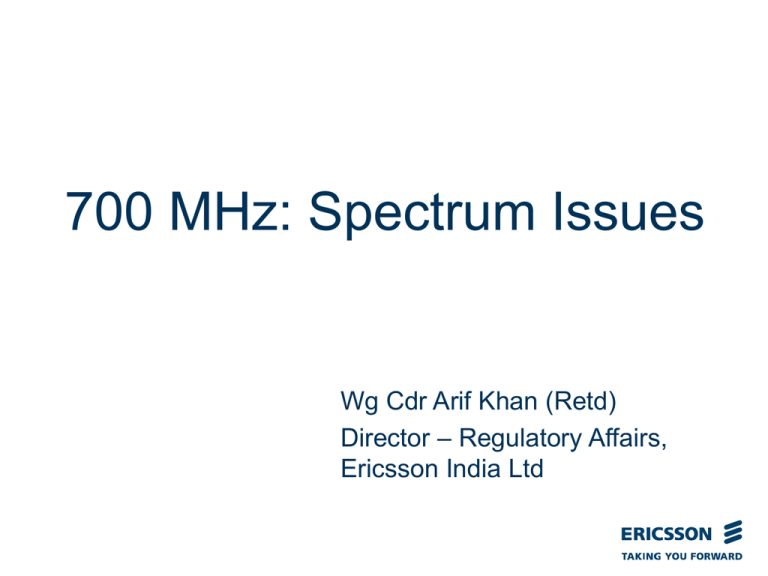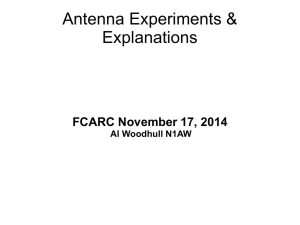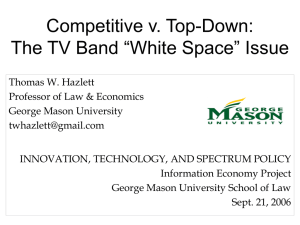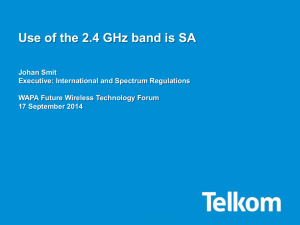790 – 862 MHz
advertisement

700 MHz: Spectrum Issues Wg Cdr Arif Khan (Retd) Director – Regulatory Affairs, Ericsson India Ltd Background Traditionally, spectrum in frequency band 470 – 862 MHz has been used for terrestrial broadcast services. Digitization of broadcast services has made parts of this free for other services. In WRC 07, Americas and 9 administrations including India and China in region 3 have identified the 698-806 MHz band for IMT (806-862 MHz had already been identified at prior WRC). Support of these key countries of the identification of this frequency band provides a significant near-term market potential in the deployment of IMT systems. In APT region there is a significant interest by the administrations to identify this band for IMT after Digital Dividend. In addition, more than 60 countries in Region 1 opted for primary allocation to mobile service of the 790-862 MHz band. © Ericsson AB 2009 The band 698-960 MHz in ITU 790 MHz BROADCASTING 862 MHz 880 MHz 960 MHz IMT-2000 GSM/WCDMA MOBILE & IMT Region 1 (EMEA) 698 MHz 806 MHz 824 MHz 894 MHz IMT-2000 cdma2000/WCDMA MOBILE & IMT Region 2 (Americas) 698 MHz MOBILE & IMT (9 countries) Momentum 790 MHz 862 MHz IMT-2000 cdma2000/WCDMA 824 MHz 960 MHz IMT-2000 GSM/WCDMA MOBILE & IMT Region 3 (APAC) © Ericsson AB 2009 880 MHz 894 MHz US 700 MHz Band Plan US is the only nation where channeling plan of 700 MHz band has been worked out. The spectrum being vacated due this digital TV transition has been allocated for deployment of IMT applications, Mobile TV and Public Safety services. Under the new band plan, the 700 MHz band is divided into two sub bands i.e. Lower band – 698-746 MHz and upper band – 746 -806 MHz. Duplex separation of FDD spectrum is kept 30 MHz. Block Frequencies Bandwidth Pairing Lower A Lower B Lower C Lower D Lower E 698-704, 728-734 704-710, 734-740 710-716, 740-746 716-722 722-728 12 MHz 12 MHz 12 MHz 6 MHz 6 MHz 2 x 6 MHz (IMT) 2 x 6 MHz (IMT) 2 x 6 MHz unpaired (Mobile TV) unpaired (Mobile TV) Upper C Upper A Upper D Upper E Upper B 746-757, 776-787 757-758, 787-788 758-763, 788-793 763-775, 793-805 775-776, 805-806 22 MHz 2 MHz 10 MHz 24 MHz 2 MHz 2 x 11 MHz (IMT) 2 x 1 MHz (GB) 2 x 5 MHz (IMT) 2 x 12 MHz (Public Safety) 2 x 1 MHz (GB) © Ericsson AB 2009 US 700 MHz Band Winners Verizon spent $9.4 billion in the auction. – 22 MHz C Block nationwide, plus another 24 MHz (A and B block) in a few key markets and 12 MHz (A or B) in other markets. – Total 46 MHz in a few key markets such as LA, Chicago, & Miami; – Total 34 MHz in many other markets; – Minimum of 22 MHz nationwide. AT&T spent over $6 billion – 233 B Block licenses - each 12 MHz – Prior to auction, AT&T acquired a large footprint on the Lower C Block, which had been auctioned in 2002 and 2003. © Ericsson AB 2009 US 700 MHz Band Winners Qualcomm spent $558 million to buy licenses in the E and B Blocks. – – – E Block (Channel 56) footprint includes 5 of the top 7 regions– extending from New Hampshire to Maryland and from Orange County to Northern California. Covers over 68 million people and 28 key markets. Qualcomm won licenses of B Block, near key R & D offices D Block could not be auctioned as the only bid of $472 million was far below the $1.33 billion reserve price. The FCC is now considering the rules for re auctioning of the D Block. Dish TV, a spin off from Echostar & one of two satellite TV operators in the US, spent $712 million for the other E Block markets. Smaller players won remaining Lower A and B block markets. © Ericsson AB 2009 European Digital Dividend band In Europe, Digital Dividend band is 790 – 862 MHz which is different from the US, India and most of the region 3 countries. Following band plan is being considered at ECC for 790 – 862 MHz band for IMT applications. – 790 – 820 MHz D/L frequency paired with 832 – 862 MHz U/L frequency – 30 + 30 MHz FDD with 42 MHz duplex separation and 820 – 832 MHz (12 MHz) as the centre gap. © Ericsson AB 2009 UHF Band assignment in India 470 – 960 MHz band is allocated for terrestrial broadcasting and Mobile services on primary basis. The 700 MHz Band spectrum, which is from 698-806 MHz, is part of the terrestrial broadcasting band. Currently, following spectrum in 470 – 960 MHz band is available for terrestrial TV broadcasting in the country: Band Spectrum (MHz) No. of TV channels in analog mode TV Channel No. UHF Band IV 470 - 582 14 21 – 34 UHF Band V 582 – 806 806 – 960 28 25 - 62 © Ericsson AB 2009 UHF Band assignment in India UHF Band IV: There are 14 TV channels available in the UHF Band-IV (470 582 MHz) with 8 MHz channel bandwidth. Doordarshan has been assigned and operating about 330 transmitters in this band. Doordarshan’s three digital TV transmitters at Kolkata, Chennai and Mumbai are also operating on an experimental basis in this band. Recently Doordarshan has started its mobile TV service in Delhi using DVB-H technology in this band at channel # 26. UHF Band-V: In this frequency band, there are 28 channels available with 8 MHz bandwidth in the sub-band from 582 to 806 MHz. Doordarshan has not been assigned any channel in this sub-band for analogue TV transmission. However, frequency 735 – 755 MHz and 775 – 795 MHz has been assigned in favor of Doordarshan to operate short distance UHF links. Also this band is shared with other users for fixed and mobile services for transmission of data/voice and video. Some of the Govt agencies are operating point to point microwave links in 610 – 806 MHz. © Ericsson AB 2009 Digital Television in India There is already a move to shift the terrestrial TV transmission from analogue to digital mode across the world. Doordarshan is also in the process of planning for up gradation of its 14 analog TV Channels transmission to digital TV transmission. Requirement for additional spectrum for digital terrestrial transmission can be met within the broadcasting bands. As projected by Doordarshan and TRAI, during the transition period from analog to digital terrestrial transmission, the spectrum requirements will increase and will have to be accommodated in 585 – 698 MHz band. TRAI has recommended that spectrum for Mobile Broadcast TV be allocated in 585 – 806 MHz band. © Ericsson AB 2009 Key issues to be considered for allocation of spectrum in 700 MHz Band in India Quantum of spectrum available for commercial use – since there are existing users in 698 – 806 MHz band and they need to vacate the spectrum, there is an urgent need to know how much spectrum will be made available in this band for IMT applications. Harmonization of spectrum – to leverage the benefits of economies of scale, there is a need to harmonize the spectrum especially in APAC region. FDD/TDD interference issue – Any channeling plan will have FDD and TDD portions of the spectrum. Sharing studies must be conducted before any spectrum allocation is done. Since, FDD offers better coverage characteristics, allocation of FDD spectrum should be preferred. © Ericsson AB 2009




